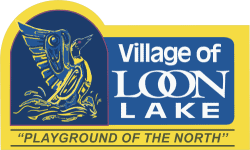The Village of Loon Lake is committed to supporting community health and safety by offering residents the opportunity to borrow a radon detector. Contact the office for more information.
What is Radon?
Radon is a radioactive gas that occurs naturally when the uranium in soil and rock breaks down. It is invisible, odourless and tasteless. When radon is released from the ground into the outdoor air, it is diluted and is not a concern. However, in enclosed spaces like homes, it can accumulate to high levels. High radon levels can be a risk to the health of you and your family.
How can Radon get into your home?
Radon gas moves through the ground and escapes outside or into buildings.
Radon can enter a home any place it finds an opening where the house is in contact with the ground: cracks in foundation walls and in floor slabs, construction joints, gaps around service pipes, support posts, window casements, floor drains, sumps or cavities inside walls.
What are the Radon levels in Canada?
All homes in Canada have radon gas in them. Concentrations differ greatly across the country, but are usually higher in areas where there is a higher amount of uranium in underlying rock and soil. Radon levels can vary from home to home, so testing is the only way to know the radon levels in your home. No matter the age, type of construction or where your home is located, the only way to be sure of the radon level in your home is to test.
What is the current Canadian Guideline for Radon in indoor air?
The Canadian guideline for radon in indoor air for dwellings is 200 Becquerels per cubic metre (200 Bq/m3). A Becquerel is a unit that measures the emission of radiation per second. The radon level in a dwelling should not be above the guideline. While the health risk from radon exposure below the Canadian guideline is small there is no level that is risk free. It is the choice of each homeowner to decide what level of radon exposure they are willing to accept.
How can I reduce the amount of radon in my home?
You should fix your home if your radon test result is above the guideline of 200 Bq/m3. Techniques to lower radon levels are effective and can save lives. Health Canada recommends that you hire a mitigation professional certified under the Canadian National Radon Proficiency Program (C-NRPP) ) to help you find the best way to reduce the radon level in your home.
The most common radon reduction method is called sub-soil depressurization. This system works by sucking air (and radon gas) from beneath the foundation of a home and exhausting it outside. Installation of this system generally consists of a pipe installed through the foundation floor and connected to an outside wall or up through to the roof line. A small fan is attached to the pipe which draws the radon from below the house to the outside before it can enter your home.
To find a certified mitigator, visit www.c-nrpp.ca or call 1-855-722-6777.
Where can I learn more??
Visit canada.ca/radon or call 1-833-723-6600, TTY – 1-800-465-7735 for more information on radon.

